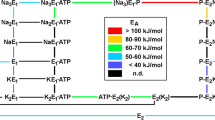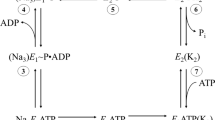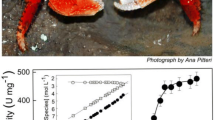Abstract
Phosphatase activity of a kidney (Na + K)-ATPase preparation was optimally active with Mg2+ plus K+. Mn2+ was less effective and Ca2+ could not substitute for Mg2+. However, adding Ca2+ with Mg2+ or substituting Mn2+ for Mg2+ activated it appreciably in the absence of added K+, and all three divalent cations decreased apparent affinity for K+. Inhibition by Na+ decreased with higher Mg2+ concentrations, when Ca2+ was added, and when Mn2+ was substituted for Mg2+. Dimethyl sulfoxide, which favorsE 2 conformations of the enzyme, increased apparent affinity for K+, whereas oligomycin, which favorsE 1 conformations, decreased it. These observations are interpretable in terms of activation through two classes of cation sites. (i) At divalent cation sites, Mg2+ and Mn2+, favoring (under these conditions)E 2 conformations, are effective, whereas Ca2+, favoringE 1, is not, and monovalent cations complete. (ii) At monovalent cation sites divalent cations compete with K+, and although Ca2+ and Mn2+ are fairly effective, Mg2+ is a poor substitute for K+, while Na+ at these sites favorsE 1 conformations. K+ increases theK m for substrate, but both Ca2+ and Mn2+ decrease it, perhaps by competing with K+. On the other hand, phosphatase activity in the presence of Na+ plus K+ is stimulated by dimethyl sulfoxide, by higher concentrations of Mg2+ and Mn2+, but not by adding Ca2+; this is consistent with stimulation occurring through facilitation of an E1 to E2 transition, perhaps an E1-P to E2-P step like that in the (Na + K)-ATPase reaction sequence. However, oligomycin stimulates phosphatase activity with Mg2+ plus Na+ alone or Mg2+ plus Na+ plus low K+: this effect of oligomycin may reflect acceleration, in the absence of adequate K+, of an alternative E2-P to E1 pathway bypassing the monovalent cation-activated steps in the hydrolytic sequence.
Similar content being viewed by others
References
Albers, R. W., and Koval, G. J. (1972).J. Biol. Chem. 247, 3088–3092.
Albers, R. W., and Koval, G. J. (1973).J. Biol. Chem. 248, 777–784.
Ash, D. E., and Schramm, V. L. (1982).J. Biol. Chem. 257, 9261–9264.
Beaugé, L. A., and Glynn, I. M. (1979).Nature (London) 280, 510–512.
Beagué, L. E., and Campos, M. A. (1983).Biochim. Biophys. Acta 729, 137–149.
Blostein, R. (1983).J. Biol. Chem. 258, 7948–7953.
Cantley, L. C. (1981).Curr. Top. Bioenerg. 11, 201–237.
Castro, J., and Farley, R.A. (1979).J. Biol. Chem. 254, 2221–2228.
Drapeau, P., and Blostein, R. (1980).J. Biol. Chem. 255, 7828–7834.
Fukushima, Y., and Post, R. L. (1978).J. Biol. Chem. 253, 6853–6862.
Glynn, I. M., and Karlish, S. J. D. (1976).J. Physiol. 256, 465–496.
Grisham, C. M., and Mildvan, A. S. (1974).J. Biol. Chem. 249, 3187–3197.
Hasen, O. (1985). InThe Sodium Pump (I. M. Glynn and J. C. Ellory, eds.), Company of Biologists, Cambridge, in press.
Huang, W.-H., and Askari, A. (1984).Arch. Biochem. Biophys. 231, 287–292.
Karlish, S. J. D. (1980).J. Bioenerg. Biomembr. 12, 111–136.
Karlish, S. J. D., Yates, D. W., and Glynn, I. M. (1978).Biochim. Biophys. Acta 525, 252–264.
Jorgensen, P. L. (1974).Biochim. Biophys. Acta 356, 36–52.
Jorgensen, P. L. (1975).Biochim. Biophys. Acta 401, 339–415.
Pedemonte, C. H., and Beaugé, L. (1983).Biochim. Biophys. Acta 748, 245–253.
Post, R. L. (1985). InThe Sodium Pump (I. M. Glynn and J. C. Ellory, eds.), Company of Biologists, Cambridge, in press.
Post, R. L., Hegyvary, C., and Kume, S. (1972).J. Biol. Chem. 247, 6530–6540.
Robinson, J. D. (1969).Biochemistry 8, 3348–3355.
Robinson, J. D. (1970).Arch. Biochem. Biophys. 139, 164–171.
Robinson, J. D. (1971).Mol. Pharmacol. 7, 238–246.
Robinson, J. D. (1972).Biochim. Biophys. Acta 274, 542–550.
Robinson, J. D. (1974).Biochim. Biophys. Acta 341, 232–247.
Robinson, J. D. (1975).Biochim. Biophys. Acta 384, 250–264.
Robinson, J. D. (1981).Biochem. Biophys. Acta 642, 405–417.
Robinson, J. D. (1982).J. Bioenerg. Biomembr. 14, 319–333.
Robinson, J. D. (1983).Curr. Top. Membr. Transport 19, 595–598.
Robinson, J. D. (1985). InThe Sodium Pump (I. M. Glynn and J. C. Ellory, eds.), Company of Biologists, Cambridge, in press.
Robinson, J. D., and Flashner, M. S. (1979).Biochim. Biophys. Acta 549, 145–176.
Robinson, J. D., and Mercer, R. W. (1981).J. Bioenerg. Biomembr. 13, 205–218.
Robinson, J. D., Levine, G. M., and Robinson, L. J. (1983).Biochim. Biophys. Acta 731, 406–414.
Robinson, J. D., Robinson, L. J., and Martin, N. J. (1984).Biochim. Biophys. Acta 772, 295–306.
Sachs, J. R. (1985). InThe Sodium Pump (I. M. Glynn and J. C. Ellory, eds.), Company of Biologists, Cambridge, in press.
Schuurmans Stekhoven, F., and Bonting, S. L. (1981).Physiol. Rev. 61, 1–76.
Schwartz, A., Matsui, H., and Laughter, A. H. (1968).Science 160, 323–325.
Skou, J. C., and Esmann, M. (1980).Biochim. Biophys. Acta 601, 386–402.
Skou, J. C. (1974).Biochim. Biophys. Acta 339, 258–273.
Swann, A. C. (1983).Arch. Biochem. Biophys. 221, 148–157.
Tashima, Y., Hasegawa, M., Mizunuma, H., and Sakagishi, Y. (1977).Biochim. Biophys. Acta 482, 1–10.
Tobin, T., Akera, T., Baskin, S. I., and Brody, T. M. (1973).Mol. Pharmacol. 9, 336–349.
Author information
Authors and Affiliations
Rights and permissions
About this article
Cite this article
Robinson, J.D. Divalent cations and the phosphatase activity of the (Na + K)-dependent ATPase. J Bioenerg Biomembr 17, 183–200 (1985). https://doi.org/10.1007/BF00751061
Received:
Revised:
Issue Date:
DOI: https://doi.org/10.1007/BF00751061




